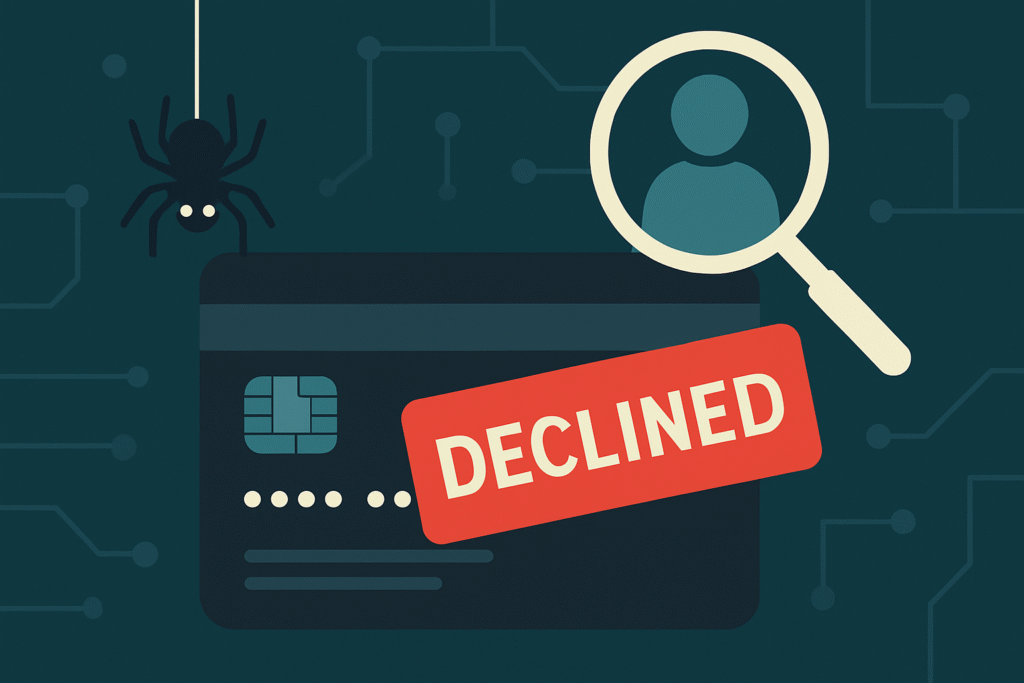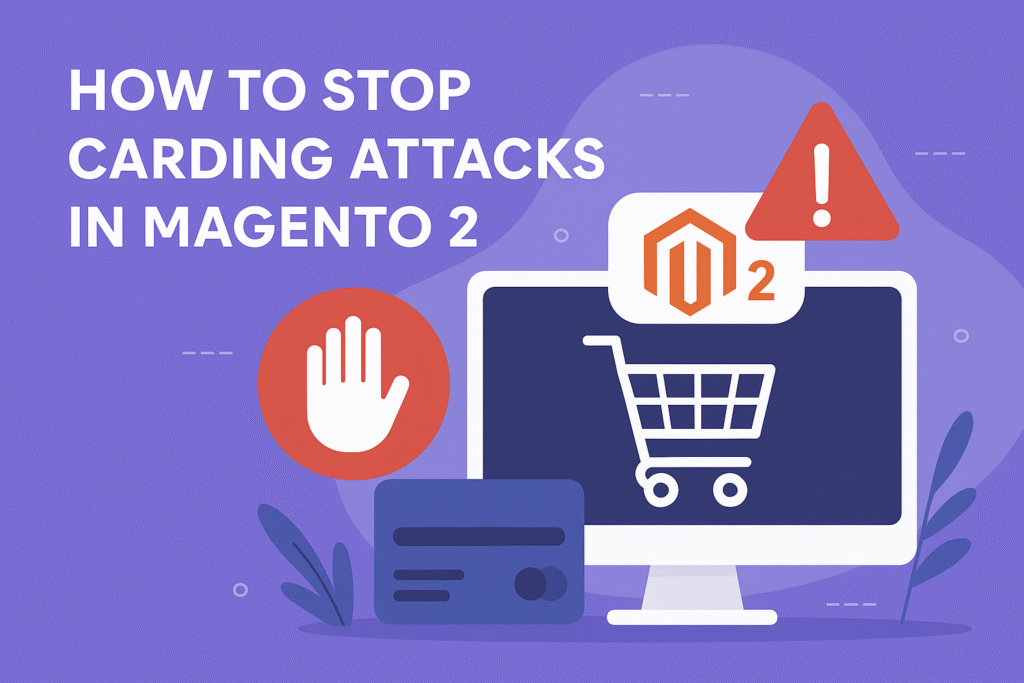9 Types of Carding Attacks eCommerce Store Watch Out For
1. Basic Carding Attack
What Is Basic Carding?
Basic carding is the most common and straightforward form of credit card fraud. In this attack, spammers or bots use large stolen databases of credit card numbers to test which cards are active and valid. The attacker automates fake purchases using scripts that simulate checkout processes to check which cards successfully authorize payments.
This method is often done rapidly using bots, targeting small eCommerce stores that lack advanced fraud protection. Because it’s cheap and easy to execute, it’s often used by beginner fraudsters.
🚨 Warning Signs to Watch For
Basic carding attacks leave behind several red flags in your store’s logs:
- Multiple failed payment attempts in a short time
- Different card numbers used on the same cart or product
- Suspicious IP behavior, like multiple countries or frequent IP changes
- Strange email addresses or random names with each checkout attempt
- If you’re noticing dozens of failed payments per hour—or strange behavior patterns on your checkout page—you could be under a carding attack.
✅ How to Protect Your Store
To defend your WooCommerce or Magento 2 store against basic carding:
- Use device fingerprinting, not just IP blocking (bots rotate IPs quickly).
- Limit failed payment attempts per session or device.
- Install a plugin like Checkout Protection that automatically detects bot behavior and blocks suspicious traffic in real time.
- Add rate limiting rules and monitor transaction logs regularly.
- Enable CAPTCHA or reCAPTCHA v3 on key pages like login and checkout.
2. Low and Slow Attacks (Stealth Carding)
What Is a Low and Slow Carding Attack?
Unlike basic carding, which floods your checkout with rapid-fire attempts, “low and slow” carding attacks are much sneakier. These attacks mimic real customer behavior to avoid detection. Instead of hundreds of failed attempts from one IP, the attacker spreads out card tests across multiple IP addresses, devices, and even over several hours or days.
They use residential proxies, rotating IPs, and realistic user agents (like Chrome on iPhone) to make the traffic look legitimate. This method makes it much harder to spot with traditional security tools.
🚨 Signs of a Stealth Carding Attack
Low and slow attacks are subtle, but they still leave clues if you know what to look for:
- Dozens or even hundreds of unique IPs accessing your checkout page
- Frequent checkout attempts spaced a few minutes apart
- Each attempt uses a different email address or slightly varied personal info
- Purchases are often for the same product or small-dollar items
- Referrer data may be missing or look unusual (e.g., direct visits only)
✅ How to Defend Against Stealth Carding
To protect your store from stealth attacks:
- Use behavior-based detection tools that track patterns across sessions—not just single IPs.
- Deploy fingerprinting technology that can recognize the same device even across rotating IPs.
- Enable bot detection tools that analyze mouse movement, scroll behavior, and interaction patterns.
- Set custom rate-limits per user, device, or session—even for successful payments.
- Install Checkout Protection, which includes stealth detection and real-time logging for all checkout attempts.
3. Authorization Testing
What Is Authorization Testing?
Authorization testing, also known as “auth testing,” is a technique where attackers submit stolen credit card details to see if a card is active or has available funds—without actually completing a purchase. Instead of capturing the full payment, they trigger a $0 or $1 “authorized” transaction which shows up as a pending charge on the cardholder’s account.
Since no product is purchased or order completed, these transactions often slip past normal fraud detection tools.
🚨 Signs of Authorization Testing
This type of attack may go unnoticed unless you review your payment gateway logs closely. Warning signs include:
- Multiple $0 or $1 “authorized” transactions, not followed by a successful payment
- High volume of pending orders with no shipping or cart activity
- Increased number of payment attempts without matching purchases
- Log entries showing attempts with different cards, same session
These small test charges are often the precursor to more damaging fraud—once a working card is identified, the fraudster may use it for larger purchases elsewhere.
✅ How to Stop Authorization Testing
Protect your WooCommerce or Magento 2 store from auth testing by taking these steps:
- Use a fraud detection plugin that flags suspicious authorization-only transactions
- Block repeated $1 authorizations from the same device or IP
- Enable strong payment rules, such as requiring full payment for order creation
- Install Checkout Protection, which monitors and blocks testing behavior automatically
- Turn on gateway-level restrictions for excessive low-value authorizations.
4. AVS/BIN Testing
What Is AVS/BIN Testing?
AVS/BIN testing is a targeted carding technique where attackers test stolen credit card numbers by manipulating billing address and ZIP code fields. The goal is to find the exact combination that will pass the Address Verification System (AVS) checks. At the same time, they may test different BINs (Bank Identification Numbers) to identify valid card issuers or regions.
Fraudsters automate these attempts to figure out what part of the billing info is valid—once they get a match, they know they can use that card on other websites with weak AVS enforcement.
🚨 Signs of AVS/BIN Testing
This type of fraud is more subtle than brute-force carding, but leaves identifiable traces:
- Same card number used with multiple ZIP codes or billing addresses
- Country mismatch between IP location and card’s BIN (e.g., U.S. IP, Indian card)
- Gateway responses showing AVS failures or partial matches
- Increased volume of declined or pending transactions with slightly varied data
These attacks are typically done in bursts, often late at night when fewer fraud alerts are actively monitored.
✅ How to Protect Against AVS/BIN Testing
To defend your store from AVS/BIN testing, implement the following steps:
- Enable strict AVS checks in your payment gateway and reject partial matches
- Use fraud plugins that log AVS mismatch patterns and block repeat attempts
- Monitor transactions for geographic mismatches between user IP and card origin
- Install Checkout Protection, which automatically detects billing info manipulation
- Add velocity limits for the number of failed address attempts per user/device
5. Email Spam Injection
What Is Email Spam Injection?
Email spam injection occurs when fraudsters or bots use fake, temporary, or disposable email addresses during the checkout process. These emails—like test123@mailinator.com or abc@tempmail.org—are created in bulk and used to test stolen credit cards without exposing the attacker’s identity.
While not directly harmful to your store’s revenue, this tactic can seriously damage your email reputation, deliverability, and customer trust, especially when your transactional emails bounce or get marked as spam.
🚨 Signs of Email Spam Injection
- You can identify this attack by monitoring email patterns and bounce logs. Common signs include:
- High number of email bounces from domains like mailinator.com, tempmail.org, or 10minutemail.com
- Unusual email formats, such as random strings or patterns (user987@example.com)
- Your store’s emails landing in customer spam folders
- Gmail, Outlook, or Yahoo flagging your sending domain or IP
- Lack of engagement metrics—low open rates, high bounce rates
Left unchecked, this can lead to your email domain being blacklisted, affecting real customers who never receive order confirmations or shipping updates.
✅ How to Prevent Email Injection
- Here’s how you can block or reduce damage from email spam injection:
- Install a fraud protection plugin that auto-blocks disposable or fake email domains
- Use a real-time email verification API to reject temporary addresses during checkout
- Monitor your transactional email bounce reports (Mailgun, SendGrid, etc.)
- Enable email domain filters in your store settings
Use Checkout Protection, which filters fake email addresses and preserves your sender reputation.
6.Mobile Emulation / Fake Device ID
What Is Mobile Emulation in Carding?
In this technique, bots try to imitate real mobile devices by faking browser fingerprints, screen sizes, user agents, and even touch input. These emulated sessions trick basic bot detection tools into thinking a real person is using a phone or tablet, making it harder to detect suspicious activity.
Fraudsters often use headless browsers or mobile emulators to simulate normal shopping behavior—scrolling, tapping, or navigating your site—while running automated tests with stolen card data.
🚨 Signs of Mobile Emulation
Although these bots mimic real mobile users, they leave behind patterns that can be tracked with the right tools:
- Strange or rare mobile screen resolutions not matching common devices
- Multiple devices with identical behaviors like identical scroll paths or interaction timing
- Same checkout flow repeated across dozens of “unique” devices
- Frequent use of mobile browsers without typical mobile traffic patterns (e.g., no product views)
Without advanced fingerprinting, it’s difficult to separate real mobile traffic from bots pretending to be mobile users.
✅ How to Defend Against Mobile Emulation
Protecting your store from fake mobile device attacks requires more than basic firewalls:
- Use browser fingerprinting tools that detect inconsistencies in emulated devices
- Monitor device behavior—real users tap, pause, scroll, not repeat the same exact path
- Flag rare or suspicious screen resolutions and user-agent combinations
- Enable advanced bot protection like Checkout Protection, which detects fake mobile fingerprints in real time
Implement behavior analysis scripts to track engagement and flag robotic patterns
7. Fake Order Flooding
What Is Fake Order Flooding?
Fake order flooding is a form of denial-of-service (DoS) attack targeting your inventory, not your server. In this method, bots add large quantities of items to the cart or reach the checkout page—but never complete the purchase. The goal is to hold your products in limbo, making them appear “sold out” or unavailable to real customers.
This tactic is especially popular during limited releases, sneaker drops, or flash sales, where inventory is limited and timing is critical.
🚨 Signs of Inventory Denial Attacks
Here are the key warning signs that suggest your store is being flooded with fake orders:
- Sudden spikes in cart activity or abandoned checkouts
- Products show “out of stock” but no actual purchases are completed
- Large quantities of a single item are held in multiple carts
- Massive increase in pending orders or incomplete transactions
- Checkout attempts from multiple regions/IPs with no follow-through
This attack causes loss of real sales, damages customer experience, and skews your analytics.
✅ How to Prevent Fake Order Flooding
Protecting against inventory denial requires smarter limits and fraud filtering:
- Limit cart hold time to automatically clear unpaid carts after a short duration
- Use Checkout Protection to identify and block bots that add to cart without intent to buy
- Restrict quantity per order/IP for high-demand products
- Implement CAPTCHA or challenge-response checks before checkout
- Monitor your inventory logs for unusual cart patterns or spikes
8. Checkout Page Probing
What Is Checkout Page Probing?
Checkout page probing is a pre-attack technique where bots scan your website—especially the cart and checkout pages—to map out your form structure, identify vulnerabilities, and prepare for future attacks like carding, fake orders, or injection attacks.
These bots look for hidden fields, token structures (like CSRF tokens), and routing patterns. Once they understand how your checkout works, they can simulate it at scale and launch more effective automated fraud attempts.
🚨 Signs of Checkout Page Probing
Though no payments are made, this probing phase leaves behind clear indicators in your server logs:
- Unusual POST or GET requests to cart, checkout, or API endpoints
- Missing or invalid CSRF tokens in form submissions
- Requests to uncommon URLs (e.g., /wp-json/, /checkout?step=2, /rest/V1/guest-carts/)
- High frequency of bot traffic with little to no user interaction (no cart adds, no clicks)
- Increased 400/403 error logs, often from malformed requests
If these bots succeed, your store could be mapped and exploited without you realizing it—until the fraud begins.
✅ How to Block Checkout Probing
To stop checkout probing and secure your checkout flow:
- Use bot detection tools that analyze request behavior, not just IP
- Validate all tokens (e.g., CSRF, form IDs) and reject suspicious submissions
- Install Checkout Protection, which detects probing patterns and blocks access
- Hide or randomize field names and endpoints for sensitive checkout forms
- Enable server-side request logging to track access to cart and checkout paths
9. Rate Abuse / Reward Abuse
What Is Rate or Reward Abuse?
Rate abuse, also known as reward abuse, happens when fraudsters use stolen credit cards to buy low-cost items repeatedly and harvest rewards, such as points, coupon codes, gift cards, or referral bonuses. Since the purchases are small, they often go undetected—but the cumulative loss in promo value, loyalty points, and fraud fees can be substantial.
This type of abuse can also come from repeat customers exploiting loopholes, like stacking discount codes or gaming referral systems using fake accounts.
🚨 Signs of Reward Abuse
While this kind of abuse may not trigger immediate fraud alerts, here are common red flags:
- High volume of low-value purchases (e.g., $1–$5 range)
- Same person using different cards or emails repeatedly
- Excessive use of coupon codes or gift card redemptions
- Unusual patterns in loyalty program use or referrals
- Multiple shipping addresses linked to one IP or device
Over time, this behavior damages your promotion ROI, clogs up inventory, and may even lead to payment processor issues due to excessive chargebacks.
✅ How to Prevent Rate and Reward Abuse
Here’s how to reduce or eliminate this form of fraud:
- Set limits on promo code usage per customer or IP address
- Track device fingerprinting to prevent multiple fake accounts from the same device
- Flag repeated low-value orders from the same buyer or device
- Monitor loyalty and referral systems for suspicious patterns



